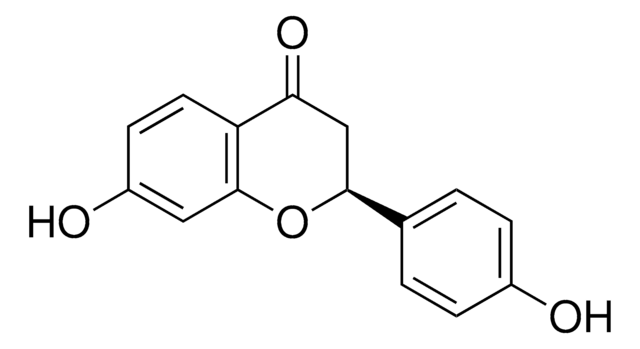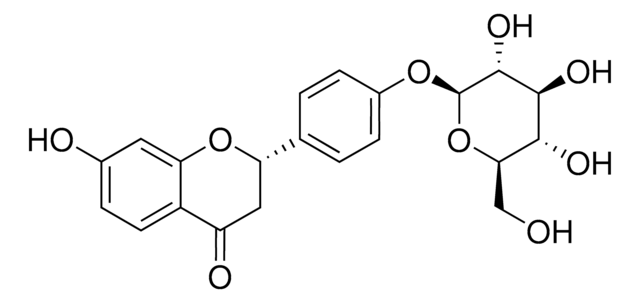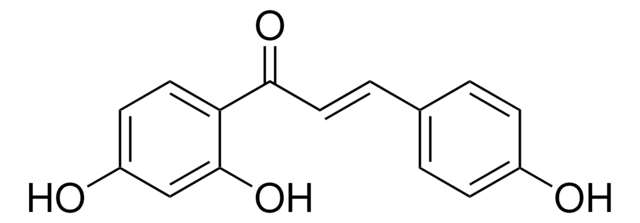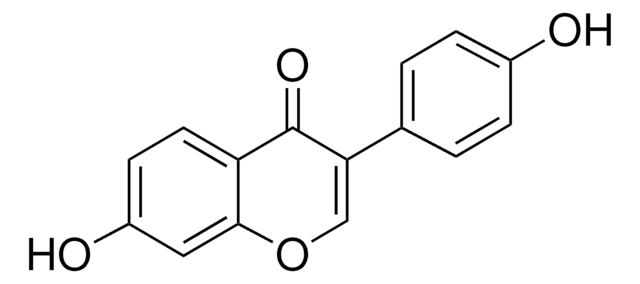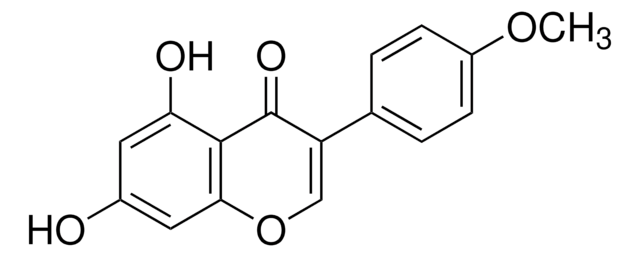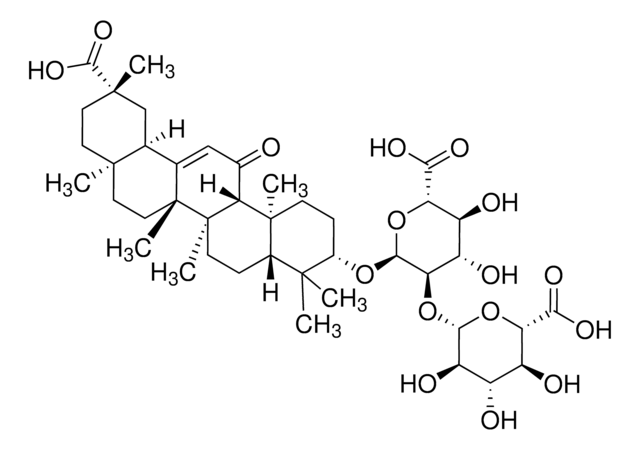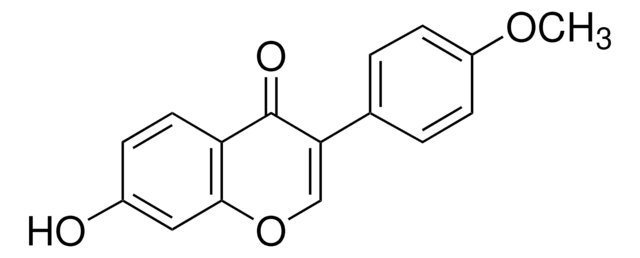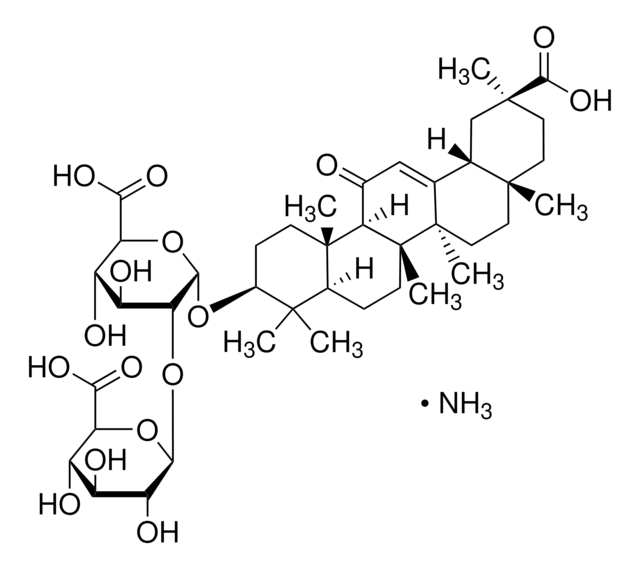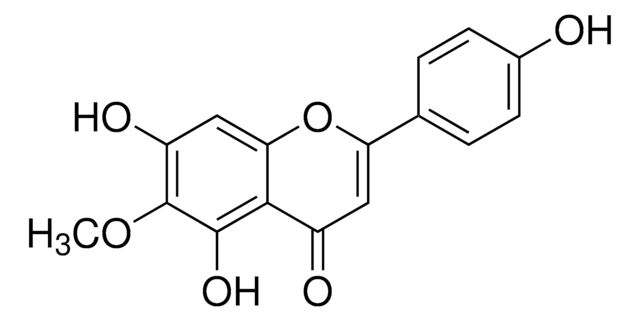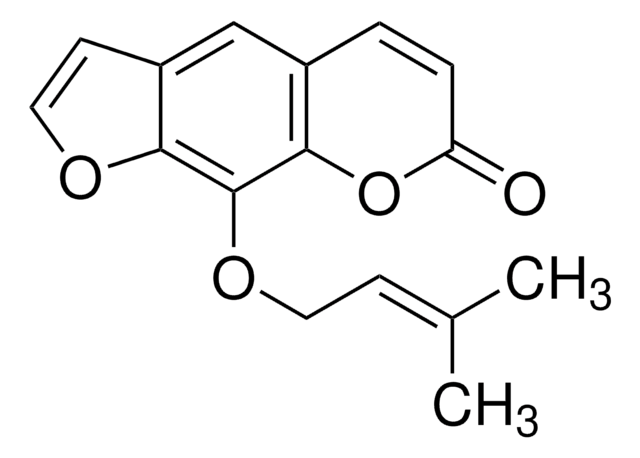78825
Liquiritigenin
≥97.0% (HPLC)
Sinônimo(s):
7,4′-Dihydroxyflavanone, 7-Hydroxy-2-(4-hydroxyphenyl)-2,3-dihydro-4H-1-benzopyran-4-one
Faça loginpara ver os preços organizacionais e de contrato
About This Item
Fórmula empírica (Notação de Hill):
C15H12O4
Número CAS:
Peso molecular:
256.25
Beilstein:
359378
Número MDL:
Código UNSPSC:
12352202
ID de substância PubChem:
NACRES:
NA.28
Produtos recomendados
Nível de qualidade
Ensaio
≥97.0% (HPLC)
Formulário
powder or crystals
Impurezas
≤7% water
aplicação(ões)
metabolomics
vitamins, nutraceuticals, and natural products
cadeia de caracteres SMILES
Oc1ccc(cc1)[C@@H]2CC(=O)c3ccc(O)cc3O2
InChI
1S/C15H12O4/c16-10-3-1-9(2-4-10)14-8-13(18)12-6-5-11(17)7-15(12)19-14/h1-7,14,16-17H,8H2/t14-/m0/s1
chave InChI
FURUXTVZLHCCNA-AWEZNQCLSA-N
Descrição geral
Liquiritigenin is a flavonoid and an estrogenic compound found in licorice (Glycyrrhizae radix) root extract and several other plants.
Aplicação
Liquiritigenin has been used:
- to study its inhibitory effect on tumor metastasis in the treatment of colorectal cancer
- as a reference standard for ultra-performance liquid chromatography (UPLC) of Chaihu-Shugan-San (CSS) extract
- as a potential antiviral drug against hepatitis C virus (HCV) infection
Ações bioquímicas/fisiológicas
Liquiritigenin displays anti-diabetic and choleretic properties. It exerts anti-inflammatory activity on Raw246.7 cells by inhibiting nuclear factor kappa light chain enhancer of activated B cells (NF-κB)-dependent-induction of inducible NOS (iNOS). Liquiritigenin inhibits liver fibrogenesis by blocking Hippo/Yes-associated protein (YAP) and transforming growth factor-β1 (TGF-β1)/small mothers against decapentaplegic (Smad) components. It is a selective estrogen receptor β agonist cells. Liquiritigenin induces apoptosis in SMM-721 cells by disruption of the mitochondrial membrane potential and increased production of reactive oxygen species.
Embalagem
Bottomless glass bottle. Contents are inside inserted fused cone.
Código de classe de armazenamento
11 - Combustible Solids
Classe de risco de água (WGK)
WGK 3
Ponto de fulgor (°F)
Not applicable
Ponto de fulgor (°C)
Not applicable
Escolha uma das versões mais recentes:
Já possui este produto?
Encontre a documentação dos produtos que você adquiriu recentemente na biblioteca de documentos.
Os clientes também visualizaram
Shi-ping Zhang et al.
Food and chemical toxicology : an international journal published for the British Industrial Biological Research Association, 47(4), 693-701 (2009-01-20)
Liquiritigenin is a flavanone existed in Radix glycyrrhizae. The objective of this study is to explore the effects of liquiritigenin on SMMC-7721 cells and its possible mechanism. The viability of liquiritigenin treat cells was decreased in a dose-dependent manner assayed
Gangadhara R Sareddy et al.
Molecular cancer therapeutics, 11(5), 1174-1182 (2012-03-24)
Gliomas are the most common and devastating central nervous system neoplasms. A gender bias exists in their development: females are at lower risk than males, implicating estrogen-mediated protective effects. Estrogen functions are mediated by two estrogen receptor (ER) subtypes: ERα
Suengmok Cho et al.
Bioorganic & medicinal chemistry, 20(11), 3493-3501 (2012-05-01)
Licorice (Glycyrrhiza glabra, GG) is one of the most frequently used herbal medicines worldwide, and its various biological activities have been widely studied. GG is reported to have neurological properties such as antidepressant, anxiolytic, and anticonvulsant effects. However, its hypnotic
Eun Mi Choi
International immunopharmacology, 12(1), 139-143 (2011-11-26)
Liquiritigenin is one of the flavonoids present in Glycyrrhizae radix. In the present study, the effects of liquiritigenin on the function of osteoblastic MC3T3-E1 cells were studied. Liquiritigenin caused a significant elevation of cell growth, alkaline phosphatase activity, collagen synthesis
Eun-Ju Yang et al.
Neurotoxicology, 39, 114-123 (2013-09-10)
The progressive death of neurons following exposure to high concentrations of glutamate leads to loss of learning and memory and pathogenesis of neurodegenerative disorders. Therefore, identification of drugs that protect against glutamate-mediated neuronal cell death is a good strategy for
Nossa equipe de cientistas tem experiência em todas as áreas de pesquisa, incluindo Life Sciences, ciência de materiais, síntese química, cromatografia, química analítica e muitas outras.
Entre em contato com a assistência técnica